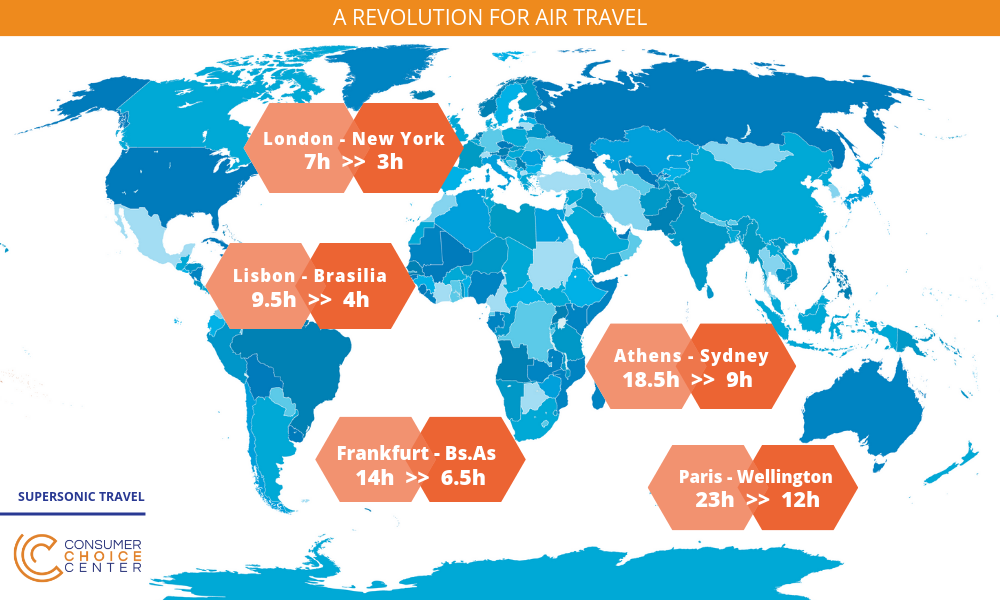Air travel experiences are in constant flux. We often see the biggest change in the technology, the area of safety, and the expectations of passengers. More consumers are travelling by plane than ever before, connecting people, friends and families across long distances. The Consumer Choice Center applauds the availability of air transport as a connector for everyone. As innovation progresses, we also see innovative types of aircraft hitting the market, increasing fuel efficiency and reducing costs for consumers and airlines.
One such area is supersonic travel, which has made considerable advancements since its alleged technological end in 2003. New aircraft have better fuel efficiency and are less noisy than early models, and could revolutionise intercontinental air travel.
Since the 1960s, air travel has been forced to slow downd. According to Kate Repantis from MIT cruising speeds for commercial airliners today range between 480 and 510 knots (889-945 km/h), compared to 525 knots (972 km/h) for the Boeing 707, a mainstay of 1960s jet travel. By today’s standards, these are average travel times:
London-New York: 8 hours
Madrid-Brasilia: 9 hours 30 minutes
Frankfurt-Buenos Aires: 14 hours
Athens-Sydney: 18 hours 30 minutes
Paris-Wellington (NZ): 23 hour
New technologies under current development promise a massive decrease in flight times. Reform of current regulatory aviation regimes would allow these technologies to compete with existing plane types and have the potential to make flying faster and thus more convenient for millions of passengers.
In past decades, most of the innovation in long-haul commercial passenger aviation was in-cabin products. Both soft and hard products in the cabin have been improving a lot in recent years. This can be seen in individual entertainment screens in economy class, the emergence of a premium economy class, flatbeds and a la carte dining in business class, and showers and enclosed suites in first class. Additionally, new planes reduced in-cabin noise, introduced wireless internet, improved ambient lighting and increased the humidity. These are all massive improvements in passenger comfort that all aim to treat symptoms of long flights: boredom and tiredness. Massive suites and showers might be less necessary for premium passengers, however, if the total flight time was drastically reduced.
Long flight times have adverse consequencesfor passengers, ranging from general discomfort to serious problems in medical emergencies. The latter is particularly consequential at cruising altitude over an ocean. Shorter flight times could, therefore, reduce the number of emergency landings caused by medical situations. In a more general sense, spending less time on an aircraft also contributes positively to the health of frequent travellers.
Shorter travelling times could also reduce incidences of violence stemming from fatigue and stress levels, often exacerbated by long flight times. This would contribute to the safety of both the flight crews and other passengers. Shorter flight times would also be beneficial for the exposure of cabin crew to the stress of long haul flights.
Other benefits of reduced flight times would be purely administrative. Today, city administrations and local communities must strike a balance between the amount of night time flights needed for economic prosperity and the necessary calm needed in the residential areas surrounding airports. Traditionally there are ‘rush hours’ for airports early in the morning and late in the evening to make red-eye flights to other continents feasible. Massively faster flight technologies such as super- and hyper-sonic planes might make red-eye flights less necessary. Reduced flight times could lead to faster and more numerous connections per day, which would cut down on nighttime flight necessities.
Reducing flight times would not only be beneficial in the aforementioned situation. It would also benefit the comfort of both business and pleasure travellers. While a traveller visiting his or her relatives might not be in a significant rush, a business traveller certainly is. Allowing for faster travel means more effective meetings and greater opportunities for international trade. The move would also contribute to tourism as long flight times serve as an excuse for tourists from many parts of the world not to visit Europe.
The United States Federal Aviation Administration (FAA) has announced that it wants to grow the supersonic civil aviation industry. Europe should follow in its footsteps.
Consumers have an expectation in favour of faster transportation. This can be assured with modern supersonic air travel.
Different flight routes require different types of aircraft. Supersonic planes would revolutionise intercontinental air travel with increased speed. Certain supersonic models would be able to reach speeds up to 2,300 km/h, which represents 2.5 times the speed of today’s commercial airliners.
